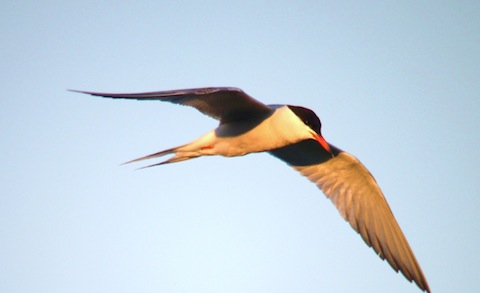 Abraham Lincoln
If given the truth, the people can be depended upon to meet any national crisis...
Abraham Lincoln
If given the truth, the people can be depended upon to meet any national crisis...
 Guildford news...
for Guildford people, brought to you by Guildford reporters - Guildford's own news service
Guildford news...
for Guildford people, brought to you by Guildford reporters - Guildford's own news service
Birdwatcher’s Diary No.14
Published on: 6 Aug, 2012
Updated on: 20 Aug, 2012
[thethe-image-slider name=”Birdwatcher’s diary 15″]
By Malcolm Fincham
Alas it’s farewell to our common terns at Stoke Lake, but not a sad one for me – in many ways a very happy one. Having followed them though a successful breeding season, it was a delight to watch the last remaining adult (presumably the male) spend the last few days of his stay, still going through the motions of catching fish and returning to the raft with no one left to feed.
Watched him for the last time on Saturday, July 28, (when I took the above photos), all of them will now hopefully be making their journey back to a coastal area of South Africa where they will spend their time before, “on a wing and a prayer”, they will return to breed again next year.
The terns are not the only ones to have gone. The Guidford branch of the swift family also seem to have departed. I had not seen any over my home to the north of Guildford for well over a week now, with just the one high in the sky over Wonersh on Friday, August 3.
There are, however, plenty of other ‘hirundines’ about, such as swallows and house martins still wheeling around the sky (in more rural areas). But generally speaking the swifts are always the last of them to arrive in this country and the first to go back.
Looking to the skies can be a fruitful pastime and not advised while driving a car! Red kites continue to be reported at various locations in the Guildford area; and although not high in the sky at the time, I too had the fortune of spotting one flying low across a field off Northcote Lane in Shamley Green on Thursday, August 2.
A concerning bit of news came my way on Thursday August 2 from Paul (who kindly added the vidio clips to a previous report) to say he had just seen a mink swimming across the river near to Stoke Lock. He also reported the sighting to Guildford Borough Council’s countryside department.
As cute as they may look, they are walking, swimming, killing machines native to America; once farmed in this country for their fur. Many are now known to roam near our rivers and are reckoned to be wreaking havoc on our native species.
My instant concern was: “What’s happened to the grey wagtails that were nesting by the river bank near to that location?”

"Found any?" - "Nope, it all looks green to me!" (See Opinion: The Future is Congested, the Future is Grey)
www.abbotshospital.org/news/">





Recent Articles
- Latest Evidence in Sara Sharif Trial
- Ash’s New Road Bridge Is Named – and November 23rd Is Opening Day
- Class A in Underwear Leads to Jail Sentence
- Historical Almshouse Charity Celebrates Guildford in Bloom Victory
- Notice: Shalford Renewable Showcase – November 16
- Firework Fiesta: Guildford Lions Club Announces Extra Attractions
- Come and Meet the Flower Fairies at Watts Gallery
- Updated: Royal Mail Public Counter in Woodbridge Meadows to Close, Says Staff Member
- Letter: New Developments Should Benefit Local People
- Open Letter to Jeremy Hunt, MP: Ash’s Healthcare Concerns


Search in Site
Media Gallery
Dragon Interview: Local Artist Leaves Her Mark At One of England’s Most Historic Buildings
January 21, 2023 / No Comment / Read MoreDragon Interview: Lib Dem Planning Chair: ‘Current Policy Doesn’t Work for Local People’
January 19, 2023 / No Comment / Read MoreA3 Tunnel in Guildford ‘Necessary’ for New Homes, Says Guildford’s MP
January 10, 2023 / No Comment / Read More‘Madness’ for London Road Scheme to Go Ahead Against ‘Huge Opposition’, Says SCC Leader
January 6, 2023 / No Comment / Read MoreCouncillor’s Son Starts Campaign for More Consultation on North Street Plan
December 30, 2022 / No Comment / Read MoreCounty Council Climbs Down Over London Road Works – Further ‘Engagement’ Period Announced
December 14, 2022 / No Comment / Read MoreDragon Interview: GBC Reaction to the Government’s Expected Decision to Relax Housing Targets
December 7, 2022 / No Comment / Read MoreHow Can Our Town Centre Businesses Recover? Watch the Shop Front Debate
May 18, 2020 / No Comment / Read More









Recent Comments